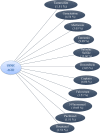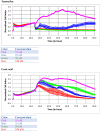The comparison of miRNAs that respond to anti-breast cancer drugs and usnic acid for the treatment of breast cancer
- PMID: 33128199
- PMCID: PMC7695759
- DOI: 10.1007/s10616-020-00430-7
The comparison of miRNAs that respond to anti-breast cancer drugs and usnic acid for the treatment of breast cancer
Abstract
This study was designed to compare usnic acid with anti-breast cancer drug molecules (A-BCDM) routinely used in the treatment of breast cancer. The miRNA information of 17 anti-breast cancer drug used in breast cancer treatment was obtained from the Small Molecule-miRNA Network-Based Inferance (SMIR-NBI) tool. We had been determined common and different expressed miRNAs between 17 A-BCDM & usnic acid and were classified according to the common miRNAs to reveal molecular similarity. As a result of the bioinformatic analyzes, 20 common miRNAs were determined between 17 A-BCDM and usnic acid. The common miRNAs were analyzed with bioinformatic tolls for determining pathways and targets. The most common miRNAs for 6 of 17 A-BCDM and usnic acid were determined as miR-374a-5p and miR-26a-5p. We compared the anti-proliferative effect of usnic acid and one of the 17 A-BCDM that tamoxifen on MDA-MB-231 triple negative breast cancer cell with real-time cell analysis system. The real time PCR assay was carried out with miR-26a-5p for evaluate to expression level of MDA-MB-231 breast cancer cell and MCF-12A non-cancerous epithelial breast cell. As a result of study, usnic acid as novel candidate drug molecule showed high similarity ratio with 5-Fluorouracil, Sulindac Sulfide, Curcumin and Cisplatin A-BCDM used in treatment of breast cancer. miR-26a-5p as common response miRNA of usnic acid and tamoxifen was showed a decreased level of expression by validated qRT-PCR assay. The obtained from study, in addition to 17 A-BCDM, usnic acid has also the potential to be used as a candidate molecule in the treatment of breast cancer. Moreover, miR-26a-5p might be used as a biomarker in the treatment of breast cancer but further analysis is required.
Keywords: Anti-breast cancer drugs; Breast cancer; Usnic acid; miRNA.
Conflict of interest statement
The authors declare that they have no conflict of interest.
Figures







Similar articles
-
Determination of Dysregulated miRNA Expression Levels by qRT-PCR after the Application of Usnic Acid to Breast Cancer.Anticancer Agents Med Chem. 2020;20(5):548-558. doi: 10.2174/1871520619666190923163552. Anticancer Agents Med Chem. 2020. PMID: 31549595
-
Revealing the Molecular Signatures of miR-185-5p on Breast Cancer Cells Using Proteomic Analysis.Protein Pept Lett. 2024;31(9):681-695. doi: 10.2174/0109298665322427240906060626. Protein Pept Lett. 2024. PMID: 39323334
-
Differences of time-dependent microRNA expressions in breast cancer cells.Noncoding RNA Res. 2020 Dec 19;6(1):15-22. doi: 10.1016/j.ncrna.2020.12.001. eCollection 2021 Mar. Noncoding RNA Res. 2020. PMID: 33385103 Free PMC article.
-
miR-185-5p response to usnic acid suppresses proliferation and regulating apoptosis in breast cancer cell by targeting Bcl2.Biol Res. 2020 May 4;53(1):19. doi: 10.1186/s40659-020-00285-4. Biol Res. 2020. PMID: 32366289 Free PMC article.
-
Prospectives of mirna gene signaling pathway in triple-negative breast cancer.Pathol Res Pract. 2023 Aug;248:154658. doi: 10.1016/j.prp.2023.154658. Epub 2023 Jun 30. Pathol Res Pract. 2023. PMID: 37421840 Review.
Cited by
-
Investigation of the immunological effects of escitalopram oxalate in the breast cancer co-culture model.Asian Biomed (Res Rev News). 2024 Jun 28;18(3):133-145. doi: 10.2478/abm-2024-0019. eCollection 2024 Jun. Asian Biomed (Res Rev News). 2024. PMID: 39175950 Free PMC article.
-
Hepatotoxicity of usnic acid and underlying mechanisms.J Environ Sci Health C Toxicol Carcinog. 2025;43(1):1-22. doi: 10.1080/26896583.2024.2366737. Epub 2024 Jun 21. J Environ Sci Health C Toxicol Carcinog. 2025. PMID: 38904414 Free PMC article. Review.
-
Harnessing natural compounds to modulate miRNAs in breast cancer therapy.Funct Integr Genomics. 2024 Nov 12;24(6):211. doi: 10.1007/s10142-024-01489-7. Funct Integr Genomics. 2024. PMID: 39528871 Review.
-
Strategic and Innovative Roles of lncRNAs Regulated by Naturally-derived Small Molecules in Cancer Therapy.Curr Med Chem. 2024;31(40):6672-6691. doi: 10.2174/0109298673264372230919102758. Curr Med Chem. 2024. PMID: 37921177 Review.
References
-
- Dent R, Trudeau M, Pritchard K, Hanna W, Kahn H, Sawka C, Lickley L, Rawlinson E, Sun P, Narod S. Triple-negative breast cancer: clinical features and patterns of recurrence. Clin Cancer Res. 2007;13:4429–4434. - PubMed
-
- Dinçsoy A, Cansaran Duman D. Changes in apoptosis-related gene expression profiles in cancer cell lines exposed to usnic acid lichen secondary metabolite. Turk J Biol. 2017;41:484–493.
LinkOut - more resources
Full Text Sources
Research Materials
Miscellaneous

